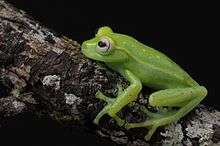Boana atlantica
Boana atlantica is a small-sized species of tree frog in the family Hylidae.[2] It is endemic to the Atlantic Forest from Pernambuco to Bahia in northeastern Brazil. It is a very abundant species inhabiting primary and secondary forest and forest edge, including degraded forest. It breeds in fish ponds, lakes and pools. It is an adaptable species but it can be locally threatened by habitat loss.[1]
| Boana atlantica | |
|---|---|
 | |
| Scientific classification | |
| Kingdom: | Animalia |
| Phylum: | Chordata |
| Class: | Amphibia |
| Order: | Anura |
| Family: | Hylidae |
| Genus: | Boana |
| Species: | B. atlantica |
| Binomial name | |
| Boana atlantica (Caramaschi & Velosa, 1996) | |
| Synonyms | |
| |
In 2017, it became the second amphibian species confirmed to be fluorescent (under UV-light), only a few months after it had been discovered in the closely related polka-dot tree frog (B. punctata).[3]
References
- Carnaval, A.C. & Pimenta, B. (2004). "Hypsiboas atlanticus". IUCN Red List of Threatened Species. 2004: e.T55401A11300906. doi:10.2305/IUCN.UK.2004.RLTS.T55401A11300906.en.
- Frost, Darrel R. (2014). "Hypsiboas atlanticus (Caramaschi and Velosa, 1996)". Amphibian Species of the World: an Online Reference. Version 6.0. American Museum of Natural History. Retrieved 31 January 2015.
- Taboada, C.; A.E. Brunetti; C. Alexandre; M.G. Lagorio; J. Faivovich (2017). "Fluorescent Frogs: A Herpetological Perspective". South American Journal of Herpetology. 12 (1): 1–13. doi:10.2994/SAJH-D-17-00029.1.
This article is issued from Wikipedia. The text is licensed under Creative Commons - Attribution - Sharealike. Additional terms may apply for the media files.
